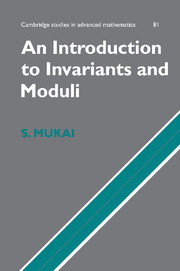Book contents
- Frontmatter
- Contents
- Preface
- Acknowledgements
- Introduction
- 1 Invariants and moduli
- 2 Rings and polynomials
- 3 Algebraic varieties
- 4 Algebraic groups and rings of invariants
- 5 The construction of quotient varieties
- 6 The projective quotient
- 7 The numerical criterion and some applications
- 8 Grassmannians and vector bundles
- 9 Curves and their Jacobians
- 10 Stable vector bundles on curves
- 11 Moduli functors
- 12 Intersection numbers and the Verlinde formula
- Bibliography
- Index
Preface
Published online by Cambridge University Press: 05 February 2015
- Frontmatter
- Contents
- Preface
- Acknowledgements
- Introduction
- 1 Invariants and moduli
- 2 Rings and polynomials
- 3 Algebraic varieties
- 4 Algebraic groups and rings of invariants
- 5 The construction of quotient varieties
- 6 The projective quotient
- 7 The numerical criterion and some applications
- 8 Grassmannians and vector bundles
- 9 Curves and their Jacobians
- 10 Stable vector bundles on curves
- 11 Moduli functors
- 12 Intersection numbers and the Verlinde formula
- Bibliography
- Index
Summary
The aim of this book is to provide a concise introduction to algebraic geometry and to algebraic moduli theory. In so doing, I have tried to explain some of the fundamental contributions of Cayley, Hilbert, Nagata, Grothendieck and Mumford, as well as some important recent developments in moduli theory, keeping the proofs as elementary as possible. For this purpose we work throughout in the category of algebraic varieties and elementary sheaves (which are simply order-reversing maps) instead of schemes and sheaves (which are functors). Instead of taking GIT (Geometric Invariant Theory) quotients of projective varieties by PGL(N), we take, by way of a shortcut, Proj quotients of affine algebraic varieties by the general linear group GL(N). In constructing the moduli of vector bundles on an algebraic curve, Grothendieck's Quot scheme is replaced by a certain explicit affine variety consisting of matrices with polynomial entries. In this book we do not treat the very important analytic viewpoint represented by the Kodaira-Spencer and Hodge theories, although it is treated, for example, in Ueno [113], which was in fact a companion volume to this book when published in Japanese.
The plan of the first half of this book (Chapters 1–5 and 7) originated from notes taken by T. Hayakawa in a graduate lecture course given by the author in Nagoya University in 1985, which in turn were based on the works of Hilbert [20] and Mumford et al. [30]. Some additions and modifications have been made to those lectures, as follows.
(1) I have included chapters on ring theory and algebraic varieties accessible also to undergraduate students. A strong motivation for doing this, in fact, was the desire to collect in one place the early series of fundamental results of Hilbert that includes the Basis Theorem and the Nullstellensatz.
(2) For the proof of linear reductivity (or complete reductivity), Cayley's Ω-process used by Hilbert is quite concrete and requires little background knowledge.
- Type
- Chapter
- Information
- An Introduction to Invariants and Moduli , pp. xi - xiiPublisher: Cambridge University PressPrint publication year: 2003



